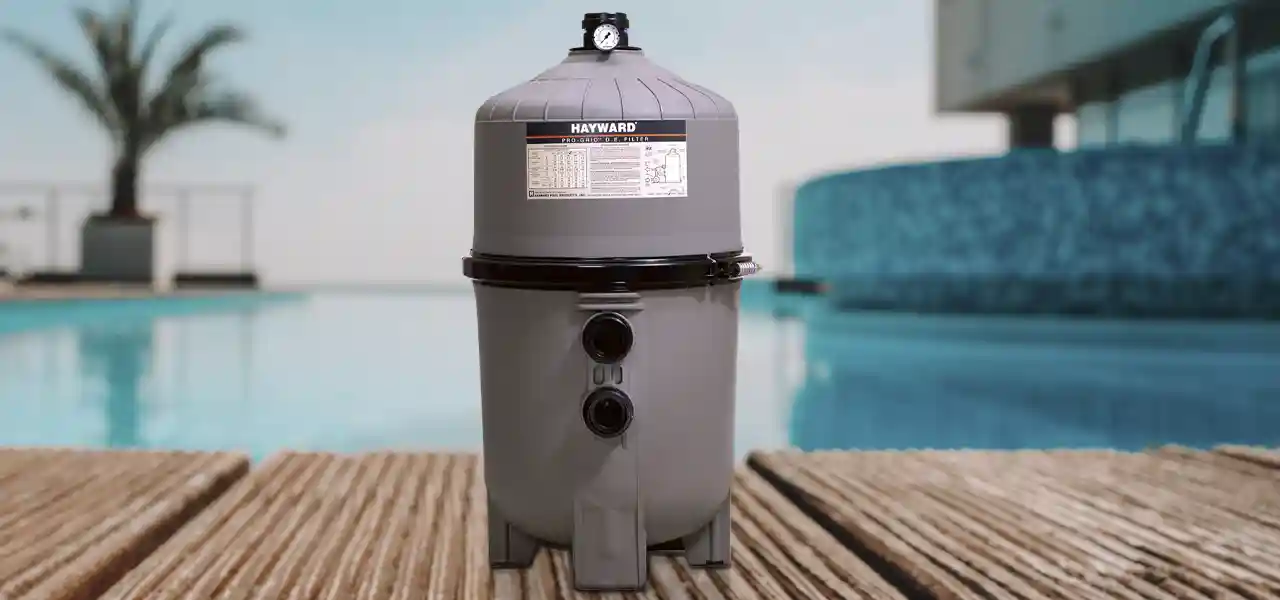FREE Standard Shipping On All Orders $100 or More!*

My D.E. Filter Keeps Clogging Up
Filtering down to a ridiculously small 2-3 microns, a diatomaceous earth (D.E.) filter far outperforms sand and cartridge filters. The result is clearer, cleaner water with fewer corrective chemicals needed, since the water has fewer suspended solids.
But being the best type of pool filter is not the only thing they say about D.E. pool filters, they are also known to require more maintenance. You have to add the D.E. powder after backwashing, and at least once per year you have to open up the tank after backwashing, and spray the grids clean - a messy and wet job.
And, because of the small pores and relatively small filter surface area, as compared to pleated cartridge filters, D.E. filter grids can get gummed-up. The thick polyester fabric is stretched over the frame and sewn tightly.
Now, here's an important distinction. The filter grid is not the filter - the powder is the filter. Grids are just the surface that the D.E. cake builds upon. After passing through the D.E. layer, the water passes through the filter grid fabric, before being pushed into the manifold and out of the filter tank.
1. D.E. Filter Grids Clogged with Oil
Small amounts of oil inevitably find their way into your open air pool. Much is brought in on the wind, or dragged in by swimmers. Pool lubricants and some gel type pool clarifiers can add oils to your pool, which eventually is trapped in the filter grids.
Using a degreaser like TSP, or our D.E. filter cleaner product, soaking to remove oils is a good treatment every year or two, to remove D.E. grid fabric clogging oils. For severe oil problems, use a pool enzyme, and use Perlite D.E. powder substitute, which has twice the oil absorption capacity as D.E. powder.
2. D.E. Filter Grids Clogged with Scale
Another type of pore-clogging material is the opposite of oily, it's scaly - minerals like calcium and magnesium, common in hard water areas, can come out of solution in certain situations, and clog a D.E. filter grid, so that hosing does not remove the scale.
Using a 10% acid solution, pour a gallon of muriatic acid into 10 gallons of clean water, in a very clean trash can. Soak the grids or grid assembly for a few hours to remove mineral scale deposits from D.E. grids. TSP or other degreasers won't remove scale, and acids won't remove oils - but our multi-purpose D.E. Pool Filter Cleaner chemical removes both oil and scale deposits.
3. D.E. Filter Grids Clogged with Baquacil
A third type of problem occurs in D.E. pool filters that are used on pools treated with Baquacil, or other Biguanide pool sanitizers. Such a well known problem in fact, that manufacturers of biguanides for pools recommend a sand filter, and recommend changing the filter sand every 1-2 seasons, or when filter cycles shorten.
4. D.E. Filter Grids Clogged with Gel Clarifiers
Certain types of pool clarifiers, such as Sparkle Plus, or MiraClear - are not compatible with D.E. filters, as they tend to gum-up the filter grid fabric, or don't backwash completely. Natural Chemistry Filter Perfect would be a good solution to removing it, after removing to hose the grids and tank clean.
5. D.E. Filter Grids Clogged with Algae
For those of you who have dealt with many algae blooms, residue from previous algae blooms can still be harboring deep inside of your filter grids. After treating a pool for algae, I like to remove the grids to hose the grids and tank completely clean.
For severe pool algae blooms, soak the entire D.E. grid assembly (after hosing clean) in a 10% bleach solution for several long minutes, before rinsing thoroughly (or soaking in the pool).
QUESTION 1:
When people tell me that their D.E. filter is clogging up in hours or a matter of days, my first question is about the size of the filter, to make sure it's large enough for the pool. Hayward Perflex D.E. filters, or small 24 SF D.E. filters installed on inground pools for instance, often need extra cleaning care.
QUESTION 2:
My second question is always "are you using enough D.E. powder?" Of course they always say they are, but remember that 1 lb of D.E. powder is more than a 16 oz cup, it's a 32 oz cup. I know that's confusing but because of it's fluffy nature, it's measured by volume. And make sure to use pool D.E. powder (or Perlite Powder) - not your garden variety type of D.E. powder used to control insects!
QUESTION 3:
Then I ask them if they have tried a D.E. filter cleaner yet? And I stress the D.E. part - because sand pool filter cleaners, or the granular stuff, are too harsh for filter grids and cartridges. Be sure to use only D.E. Pool Filter Cleaner, or the Natural Chemistry cleaner, Filter Perfect.